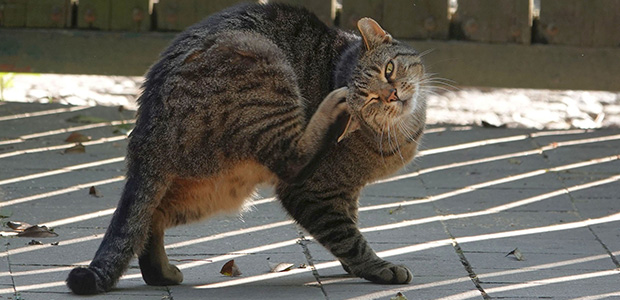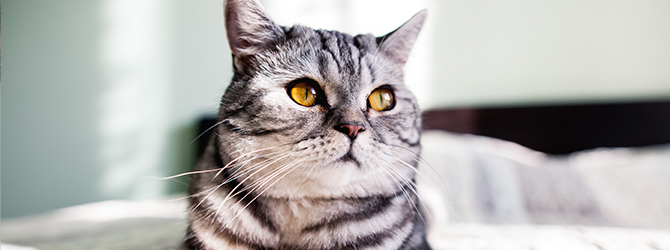Allergies in cats: does your cat have allergies?
As anyone who suffers from allergies will know, sneezing, sniffing, watery eyes and itchy skin can make life pretty miserable – and the same is true for our feline friends.
Allergies are an overexaggerated immune response to normal things in the environment. These triggers are known as allergens. Even in small amounts, allergens can stimulate an immune response, leading to inflammation and other symptoms collectively known as an allergic reaction.
Let's take a look at the different allergies cats can suffer from, and how to treat them.
Types of allergies in cats
Allergies are often triggered when a cat’s immune system overreacts to a foreign substance, or allergen. There are 4 main types of allergen:
- Food allergies
- Flea or insect bite allergies
- Environmental allergies (atopy)
- Contact allergies
Signs and symptoms of allergies in cats:
| Issue | Symptoms |
| Skin issues | Redness and itching/scratching, often around the face, paws, or base of the tail Swelling and raised, red, itchy patches on the skin Chronic ear infections are often linked to underlying allergies |
| Digestive problems | Vomiting and diarrhoea, especially with food allergies Excessive gas, which may indicate sensitivity to certain foods |
| Respiratory symptoms | Sneezing and coughing, often due to environmental allergens Wheezing and difficulty breathing |
| Behavioural changes | Increased anxiety or restlessness, which may indicate discomfort due to allergies |
Cats suffering from allergies may have a mixture of these symptoms, and it's important to speak with your vet if you’re worried about cat allergies.
What are flea and insect allergies?
Flea allergies, also known as Flea Allergy Dermatitis (FAD), happen when a cat's immune system overreacts to the proteins found in the saliva of biting parasites. A single bite from a flea can trigger an intense allergic reaction, leading to severe itching, discomfort and pain. FAD is the most common type of allergy in cats.
Flea bites
The most common cause of FAD is, of course, fleas. When fleas feed on the cat's blood, their saliva can trigger an allergic reaction.
Other insect bites
Bites from other insects, like mosquitoes, mites or ticks can also cause similar reactions to flea bites. While these are less common, they can still cause discomfort to your cat.
Symptoms of flea allergy dermatitis include
- Intense itching - presents as scratching, overgrooming, rubbing and biting at the skin
- Redness and inflammation of the skin
- Skin lesions, infections and sores
- Hair loss
If you notice any of these symptoms in your pet, it's a good idea to book an appointment with your vet. They can give you tailored advice and treatment options. For ongoing preventative care, consider joining the Pet Health Club to keep your dog, cat, or rabbit in tip-top shape.
Treatment of flea allergy dermatitis

Flea control
Proper preventative parasite treatment is the best way of treating flea-related cat allergies. This includes using vet-prescribed flea treatments regularly, such as those offered to Pet Health Club members, tailored for your cat, making sure fleas can’t spread in your home. Vacuuming and washing bedding are essential tools in the fight against fleas, as well as treating other pets.
Topical treatments
Topical treatments may be prescribed to soothe the skin, including creams or ointments containing corticosteroids or other anti-inflammatory agents. Medicated shampoos are also helpful in relieving itching and inflammation.
Medications
If your cat's allergies are severe, the vet might give them some medicine to take - either by mouth at home, or they may give an injection. Medications include drugs which alter the immune response, antihistamines or corticosteroids to control the itching and inflammation. If your cat gets an infection because of the allergies, they might need antibiotics, too.
Bathing and skin care
Gentle bathing with hypoallergenic or medicated shampoos can help soothe the skin. Regular grooming practices can support your cat's skin condition and help early detection of any issues.
Prevention
To stop problems before they start, you need to treat your cat regularly with vet-recommended flea treatments and preventatives. Keeping your home clean and treating it for fleas is really important, too.
Brushing your cat and looking for signs of fleas or other biting insects is a must. If you catch the problem early, it's much easier to sort it out.
Read more: How to get rid of fleas on cats.
Food allergies
What are food allergens?
Food allergies are not like food intolerances because they’re caused by an immune reaction rather than a digestive issue. This exaggerated immune response triggers a chain reaction that leads to various symptoms.
What foods can cause allergies?
Any food has the potential to cause an allergy, but the main triggers for cats are usually protein sources, such as:
- Fish
- Beef
- Chicken
Symptoms of food allergies
- Itching - this usually presents as scratching, excessive grooming, rubbing or biting at the skin
- Self-trauma of the skin leading to open sores and infections
- Raised, red, itchy patches on the skin
- Chronic ear infections
- Vomiting
- Diarrhoea
Treatment of food allergies
If your cat is suffering from food allergies then your vet will offer a range of treatments.

Elimination diet
Your vet may put your cat on a special food to identify the allergens causing the reaction. This involves feeding them a very controlled diet over several weeks, giving your cat’s immune system time to dial down, reducing the symptoms..
Once this phase is complete, potential allergens are gradually added to the diet, one at a time. This will pinpoint the specific food that’s causing the allergic reaction, which can then be removed from their diet. It’s really important to follow the dietary instructions very carefully, as even small amounts of the wrong food can be very problematic.
Customised diet
Once you know what's causing the allergy, you need to make sure your cat doesn't come into contact with it. This might mean getting special food from the vet that doesn't contain the ingredient that's causing the allergy.
You may also want to consider making food at home, but you need to be very careful with what you put in it to avoid deficiencies, as cats have quite specific needs from their food. Your vet can help you with this. Following this special diet should help keep your cat avoid the allergy.
Treating the cat allergy symptoms
If your cat is itching, or has inflamed skin, the vet might give them medication to relieve the symptoms and help them feel more comfortable. You may also consider a supplement, such as one containing omega-3 fatty acids, which can help with skin health.
If your cat has diarrhoea, the vet might suggest something called probiotics to help their tummy. All these treatments work together to help with the different problems allergies can cause, making sure your cat stays happy and healthy.
Prevention
Allergies are a lifelong condition, and part of management is to prevent symptoms returning. Cats with food allergies will likely need strict dietary control for the rest of their life - and this involves being careful with any novel food items including human food and cat treats. It’s also advisable to have regular veterinary check ups, to discuss their diet and their skin health.
Environmental allergies
What are environmental allergies (Atopy)?
Atopy is a long-term allergic skin condition that happens when a cat's body is overly sensitive to things in the environment, called allergens. These allergens are usually harmless to most cats, but in some cases, they can cause their immune system to overreact. This can lead to their skin becoming inflamed and irritated.
Environmental allergies include:
Pollen (from trees, grasses, and weeds)
While hay fever is a seasonal allergy, it can cause severe discomfort in your cat, as it can in people.
Dust mites
Dust mites are a common indoor allergen. They’re common in all households, and are normally found in bedding, carpets, and upholstery and can contribute to allergic reactions in sensitive cats.
Mould spores
Mould spores can be found both indoors and outdoors and often thrive in damp environments, putting areas with high humidity or water damage at high risk. They can also be a problem in low-income housing, especially for renters.
Symptoms of environmental allergies
- Intense itching - presents as scratching, overgrooming, rubbing and biting at the skin
- Redness and inflammation of the skin
- Chronic ear infections
- Seasonal flare ups
Treatment of environmental allergens
Avoiding triggers
It's essential to reduce how often your cat is exposed to possible allergens. This might mean keeping windows closed when the pollen count is high or using air purifiers to reduce airborne allergens. There are allergy tests which can be performed to find out your cat’s specific triggers.
Topical treatments
Topical treatments can soothe the skin and alleviate discomfort, including creams or ointments containing corticosteroids or other anti-inflammatory agents.
Medications
Medicines such as immunosuppressants and antihistamines may be prescribed to control itching and inflammation.
Immunotherapy
Allergen-specific immunotherapy, given as monthly injections, can gradually desensitise your cat to specific allergens over time, reducing the severity of reactions.
Bathing and skin care
Regular bathing with hypoallergenic or medicated shampoos can help soothe the skin and remove allergens from the coat, contributing to overall skin health.
Omega-3 supplements
Omega-3 fatty acid supplements can be added to your cat's diet to help make their skin healthier. This gives extra help to the skin's natural protection.
Prevention
You can help prevent problems by keeping your home clean, vacuuming often, and maybe even using air purifiers to get rid of things in the air that might bother your cat. Regular check-ups with the vet are really important to keep an eye on things and change treatments if needed.
Feeding your cat a balanced diet to keep their skin healthy is a big part of looking after them and stopping problems before they start.

Contact allergies
What are contact allergies?
Contact allergies, also known as contact dermatitis, are a type of allergic reaction that happens when your cat's skin comes into direct contact with certain substances. Unlike other allergies that may affect the entire body, contact allergies only cause reactions only at the local site of action.
Certain plants
Some plants, both indoor and outdoor, can cause allergic reactions. Knowing what plants cause this and removing them from your home can prevent discomfort.
Cleaning products
Household cleaning products, like detergents, soap, and disinfectants, can contain chemicals that irritate the skin. Using hypoallergenic alternatives can reduce these risks
Synthetic fibres (in carpets, bedding)
Materials used in carpets, bedding, or furniture, including synthetic fibres, dyes, or treatments, may cause reactions. Choose natural or hypoallergenic materials to keep your cat safe.
Rubber, plastics, metals
Items like toys, bowls, or collars made from rubber, plastics, or metals may cause localised reactions. Selecting materials known to be non-irritating can prevent these problems.
Topical medications
Sometimes, creams or ointments might cause a reaction. If you notice anything unusual, tell your vet.
Symptoms
- Intense itching at the contact site
- Redness, swelling, and inflammation
- Patterns of reaction
Treatment
Identification and removal of the allergen
The main way to treat contact allergies is to find out what's causing them and then get rid of it. You'll need to watch your cat closely and follow your vet's advice.
Topical treatments
Special creams or ointments that help calm the skin and medicated shampoos may be recommended for bathing.
Medications
If the allergies are severe, medications like antihistamines or corticosteroids may be prescribed to help stop the itching and swelling.
Bathing and skin care
Washing your cat regularly with special shampoos that are gentle on the skin can help soothe irritation and remove allergens.
Prevention
Avoid triggers
Once an allergen is identified, it should be removed from the home. This may mean changing bedding, grooming products, or household cleaning products.
Regular monitoring
Monitoring your cat will help you spot potential irritants before they cause discomfort.
Talk to your vet
If you're unsure what might be causing allergies, it's really important to talk to your vet. They can test your cat and tell you what to do to manage and stop the allergies.
The main thing is to find out what's causing the problem and make sure your cat doesn't come into contact with it. Regular visits to the vet and being careful about what's around your cat can help make sure they stay comfortable and healthy, even if they have contact allergies.
What are inhalant allergies
Inhalant allergies, also known as respiratory allergies, occur when your cat's immune system overreacts to substances carried in the air. These allergens can cause problems with your cat’s breathing and may also affect the skin.
Causes of respiratory allergies
Smoke
Exposure to smoke, whether from tobacco products or burning wood in fireplaces, can agitate the respiratory system.
Perfumes
Perfumes, air fresheners, or even scented candles might lead to respiratory or skin reactions.
Airborne chemicals
Household cleaning products, insecticides, or other chemicals may irritate the respiratory system or issues with the skin.
Pollen
Pollen might lead to seasonal symptoms affecting the respiratory system.
Symptoms
- Sneezing and coughing
- Discharge from the eyes or nose
- Wheezing
- Skin irritation
- Difficulty breathing
- Behavioural changes
Treatment
Avoiding triggers
Identify potential allergens and minimise exposure. For example, avoid smoking around the cat or use unscented cleaning products.
Air purifiers
Air purifiers equipped with HEPA filters can be effective in eliminating allergens from the air. This is especially helpful for indoor allergens like dust.
Medications
To manage symptoms, your vet may prescribe antihistamines or immunosuppressants. These can be used to treat both respiratory and skin-related symptoms.
Supportive care
Supportive care like oxygen therapy might be necessary for cats struggling to breathe. In such severe instances, immediate veterinary assistance is vital.
Regular cleaning
Keeping your home clean helps to get rid of things in the air that might bother your cat. Vacuuming, dusting, and using special cleaning products to get rid of allergens will help your cat feel better.
Prevention
Environmental control
- Keeping your home clean and free from known allergens
- Choosing cat-friendly products that don’t contain known irritants
Regular veterinary check-ups
Regular check-ups to monitor the condition and adjust treatments as necessary
Awareness of seasonal changes
Being aware of seasonal allergens like pollen and taking appropriate precautions
Whether it's avoiding tobacco smoke, using unscented products, or investing in air purifiers, small changes in the cat's environment can make a significant difference in their well-being.
Allergies in cats can be difficult for you and your cat, but with the right understanding and approach, they can be treated and managed. By recognising the signs early and working closely with your vet, you can ensure a happy and healthy life for your cat. Regular vet visits, a proactive approach, and a loving and attentive attitude can make a world of difference in your cat's quality of life.

Need more info?
For expert advice and treatment on cat allergies, contact your local vet.
Find your nearest vet using our Find a Vet page, or speak to a vet online using Online Vets.


